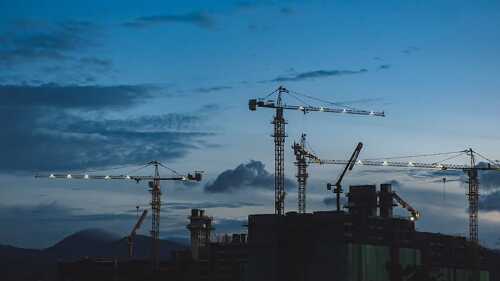| Photo by Terry Mahanna of MPhoto7 |
As municipal governments seek to improve the sustainability of their buildings—while also cutting operating costs—they are increasingly exploring the benefits of green civic structures. (See ULX: Energy-Saving Civic Buildings, May 3, 2011.) Those striving to design and build green police stations face unique challenges, including security concerns and the need to operate 24/7. The city of Henderson, Nevada’s experience with its North Community Police Station offers valuable lessons for other municipalities while also highlighting some important benefits of a green police station.
Completed in 2009, the North Community Police Station—the first Leadership in Energy and Environmental Design (LEED)-certified government building in this Las Vegas metropolitan-area city—was designed by Tate Snyder Kimsey Architects as a new prototype for the Henderson Police Department, with the goal of incorporating local and regional sustainability strategies while also reflecting the image of the police department and helping to strengthen its relationship with an older, relatively high-crime neighborhood. The 35,000-square-foot (3,252-sq-m), $12 million structure incorporates both public and secure facilities, including an entry/lobby, administrative offices, briefing and report-writing rooms, evidence handling and storage areas, locker and fitness rooms, and training rooms that also are used for community functions. The employee entrances and private work areas are oriented toward a secure parking area at the rear of the building, while the public lobby and training rooms are accessed from visitor parking areas.
To encourage visitation by the community, the designers set a neighborhood park with barbecue grills and tables on a corner of the 6.35-acre (2.57-ha) site. “We envisioned this police station as a place where families would want to come and hang out, meet the police officers, and embrace them as helpful members of their neighborhood,” says city architect Mark Hobaica. The park has become a popular setting for numerous community functions.
One of the designers’ primary goals—as with any green building—was to make ample use of daylight, thereby reducing the building’s energy use and creating a more attractive and healthier indoor environment. Because conventional windows could have made the building less secure, designers employed a wide range of strategies—including traditional skylights, light wells, round skylights lined with mirrors (solar tubes), clerestory windows, and windows at floor and ceiling levels—to bring natural light into all parts of the structure while maintaining privacy and security. These strategies have been so effective that, in many parts of the building, no artificial lighting is needed during the day.
| Photo by Terry Mahanna of MPhoto7 |
Police stations—and other civic facilities that must be occupied 24/7—typically use more energy and other resources than traditional office buildings; their energy costs alone can be two to three times as high. The installation of a 90-kilowatt photovoltaic panel system atop police vehicle carports at the North Community Police Station has resulted in tremendous energy savings; the panels currently generate nearly 40 percent of the station’s power, saving the city between $4,000 and $6,000 per month. To reduce water use, the building incorporates ultra-efficient dual-flush toilets, waterless urinals, low-flow sink fixtures, and instantaneous-use boilers that together save more than 100,000 gallons a year. The result has been a more than 40 percent reduction in water use compared with similar police stations in the city.
Other green features that helped the building achieve LEED Gold status (and brought it to within a few points of a Platinum rating) include the following:
- Building on a brownfield site.
- Reducing the use of artificial lighting with photo sensors (which turn off lights when ample daylight is present and turn them on when it gets dark) and occupancy sensors (which turn lights off when rooms are not in use).
- Incorporating a highly reflective white roof that reduces the building’s heat island effects.
- Landscaping the site with drought-tolerant desert plants and a high-efficiency drip watering system—as well as the diversion of rainwater from the parking lots through the landscaping and back into underground aquifers via a bioswale—to reduce stormwater runoff and water use.
- Incorporating green materials wherever possible, including exterior metal siding, structural steel, countertops, and carpeting made from recycled materials; cork panels (made from a rapidly renewable resource) that line many of the walls, and Forest Stewardship Council–rated plywood.
- Recycling construction waste materials; only 12 percent of construction trash went to a landfill, and an ongoing waste management and recycling program continues to limit the amount of waste produced.
- Maintaining a high level of indoor air quality by using low- or zero-volatile organic compound (VOC) products, prohibiting smoking by all workers and visitors (both during construction and after occupancy), requiring the contractor to purge the building for 36 hours before it was occupied, and installing high-efficiency air filters in all HVAC units.
- Implementing a green cleaning policy, which has been extended to all city buildings.
| 90-kilowatt photovoltaic panel system... |
While the process of greening a police station presents unique challenges, it also creates the potential for valuable benefits. The city of Henderson found that the North Community Police Station was more rapidly and completely accepted by its neighbors than a traditional police substation. According to Hobaica, “Creating this prominent structure along a major thoroughfare sends the message that a police facility can symbolize more than just law enforcement—it can be a building that demonstrates how to design and build with a more environmentally friendly approach. Green buildings are always more welcoming and acceptable in any community, no matter the function.”
Taking advantage of this acceptance, the station is used to educate the public about green buildings; signage throughout the building informs visitors about its green features and benefits. The station’s more efficient lighting has improved security while creating less light spill to annoy neighbors. Finally, the green building has resulted in a less stressful and healthier environment for those who work there, as well as for the members of the community who visit—voluntarily or otherwise.








